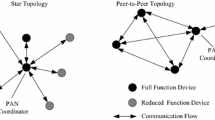Abstract
The main resource constraint in the wireless body area network is the energy. The energy consumption can be reduced by maintaining the state of a sensor. The senor node consumes less energy in the sleep state as compare to the active state. This paper develops a dynamic model that decides the state of the sensor node by using the mutual information within the nodes. The model proposes uses a short preamble to change the state of the sensor node. The model can use different routing mechanisms so the paper, firstly compares various routing technique over IEEE 802.15.4 standard which is standard for LRWPAN. The best technique among them is used for proposed model evaluation. The simulation results show the better performance of the proposed as compare to existing MAC.










Similar content being viewed by others
References
Hu, C. et al. (2013). Securing communications between external users and wireless body area networks.In Proceedings of the 2nd ACM workshop on Hot topics on wireless network security and privacy. ACM.
Malik, B., & Singh, V. R. (2013). A survey of research in WBAN for biomedical and scientific applications. Springer- Health and Technology, 3(3), 227–235.
Malik, B., & Singh, V. R. (2013). WBAN: Technology and Applications. Sensor and Transducers, 154(7), 113–119.
Gummadi, R., Wetherall, D., Greenstein, B., & Seshan, S. (2007). Understanding and mitigating the impact of rf interference on 802.11 networks. ACM SIGCOMM: Proc.
Culler, D., Estrin, D., & Srivastava, M. (2004). Overview of sensor networks. Time, 37, 41–49.
Perkins, C. (2003) Ad hoc on-demand distance vector (AODV) routing, RFC3561[S].
Alshanyour, A., & Baroudi, U. (2008). Bypass-AODV: Improving performance of ad hoc on-demand distance vector (AODV) routing protocol in wireless ad hoc networks. In Proceedings of international conference on ambient media and systems (Ambi-sys 2008).
Chakeres, I. D., & Perkins, C. E (2006). Dynamic MANET on demand (DYMO) routing protocol. Internet-Draft Version 17, IETF, October 2006, (Work in Progress). http://tools.ietf.org/html/draft-ietf-manet-dymo-17.
Reddy, B. B., & Rao, K. K. (2013). Energy optimization using cross-layer protocols in wireless sensor networks. International Journal of Computer Applications, 65(4), 18-22.
Author information
Authors and Affiliations
Corresponding author
Rights and permissions
About this article
Cite this article
Malik, B., Singh, V.R. Mutual Information Based Dynamic Model in Wireless Body Area Network. Wireless Pers Commun 84, 985–997 (2015). https://doi.org/10.1007/s11277-015-2671-0
Published:
Issue Date:
DOI: https://doi.org/10.1007/s11277-015-2671-0




